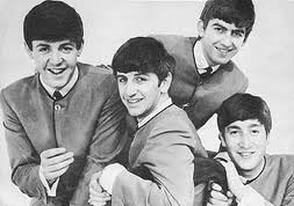The Beatles
Rapid rise to fame

The Beatles, John Lennon, Paul McCartney, George Harrison, and Ringo Starr were rooted in 1950s rock and roll. In the early 1960s, their enormous popularity first emerged as "Beatlemania", but as their songwriting grew in sophistication, they came to be perceived by many fans and cultural observers as an embodiment of the ideals shared by the era's sociocultural revolutions.
The Beatles built their reputation playing clubs in Liverpool and Hamburg over a three-year period from 1960. Moulded into a professional act by manager Brian Epstein, the creativity of producer George Martin enhanced their musical potential. They gained popularity in the United Kingdom after their first single, "Love Me Do", became a modest hit in late 1962. They acquired the nickname the "Fab Four" as Beatlemania grew in Britain over the following year, and by early 1964 they had become international stars, leading the "British Invasion" of the United States pop market. The group toured extensively around the world until August 1966, when they performed their final commercial concert. From 1966 on, they produced what many critics consider their finest material, including the innovative and widely influential albums Revolver (1966), Sgt. Pepper's Lonely Hearts Club Band (1967), The Beatles (1968), and Abbey Road (1969). After their break-up in 1970, the ex-Beatles each found success in individual musical careers. Lennon was murdered in 1980, and Harrison died of cancer in 2001. McCartney and Starr remain active. Below are some clips of early Beatles music, simple but "catchy"
The Beatles built their reputation playing clubs in Liverpool and Hamburg over a three-year period from 1960. Moulded into a professional act by manager Brian Epstein, the creativity of producer George Martin enhanced their musical potential. They gained popularity in the United Kingdom after their first single, "Love Me Do", became a modest hit in late 1962. They acquired the nickname the "Fab Four" as Beatlemania grew in Britain over the following year, and by early 1964 they had become international stars, leading the "British Invasion" of the United States pop market. The group toured extensively around the world until August 1966, when they performed their final commercial concert. From 1966 on, they produced what many critics consider their finest material, including the innovative and widely influential albums Revolver (1966), Sgt. Pepper's Lonely Hearts Club Band (1967), The Beatles (1968), and Abbey Road (1969). After their break-up in 1970, the ex-Beatles each found success in individual musical careers. Lennon was murdered in 1980, and Harrison died of cancer in 2001. McCartney and Starr remain active. Below are some clips of early Beatles music, simple but "catchy"
